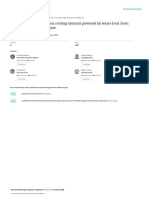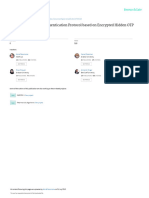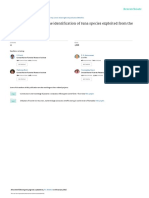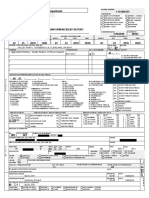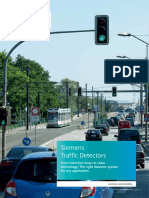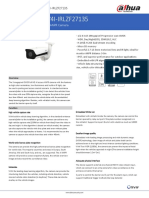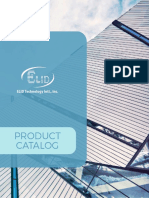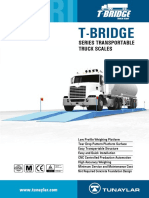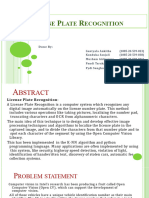See discussions, stats, and author profiles for this publication at: https://www.researchgate.
net/publication/374088193
Development of Automatic Number Plate Recognition System of Bangladeshi
Vehicle Using Object Detection and OCR
Chapter · February 2024
DOI: 10.1007/978-981-99-9524-0_25
CITATIONS READS
0 429
6 authors, including:
Abdullah Al Maruf Aditi Golder
Bangladesh University of Business and Technology Jahangirnagar University
18 PUBLICATIONS 25 CITATIONS 9 PUBLICATIONS 3 CITATIONS
SEE PROFILE SEE PROFILE
Maryam Sabah Naser Ahmad Jainul Abidin
Al-Qasim Green University Bangladesh University of Professionals
19 PUBLICATIONS 43 CITATIONS 3 PUBLICATIONS 0 CITATIONS
SEE PROFILE SEE PROFILE
All content following this page was uploaded by Abdullah Al Maruf on 26 March 2024.
The user has requested enhancement of the downloaded file.
Development of Automatic Number Plate
Recognition System of Bangladeshi
Vehicle Using Object Detection and OCR
Abdullah Al Maruf , Aditi Golder, Maryam Sabah Naser ,
Ahmad Jainul Abidin, Ananna Alom Chowdhury Giti, and Zeyar Aung
Abstract The traffic issue in Bangladesh is one of the strongest and most demanding
issues in city surveillance today. Finding and separating automobiles on the side of
the road and in the parking lot has become more crucial as Bangladesh’s traffic
congestion problem worsens at an alarming rate. There is now a lot of study being
done on the topic of object detection and classification. The detection of vehicles
and the recognition of license plates have been the subject of numerous studies. But
there are still certain restrictions. Locating the double-row number plate accurately
is one of them. In this study, we proposed a technique for locating both single-row
and double-row license plates as well as detecting the vehicle type. The suggested
model, YOLOv4 and OCR (optical character recognition) Tesseract can be utilized
to create a real-time system and has good accuracy and inference time for a variety
of illumination and style of Bangladeshi number plates. The model showed a mAP
value of almost 97%, and the other evaluation metrics performance is also acceptable.
Our proposed model outperformed the prior system.
Keywords Object detection · Vehicle · Deep learning · YOLOv4 · OCR ·
Bangladesh
A. A. Maruf · A. A. C. Giti
Bangladesh University of Business and Technology (BUBT), Dhaka, Bangladesh
A. Golder
Jahangirnagar University, Dhaka, Bangladesh
M. S. Naser
Hilla University College, Babylon, Iraq
A. J. Abidin
Bangladesh University of Professionals (BUP), Dhaka, Bangladesh
Z. Aung (B)
Khalifa University, Abu Dhabi, United Arab Emirates
e-mail: zeyar.aung@ku.ac.ae
© The Author(s), under exclusive license to Springer Nature Singapore Pte Ltd. 2024 331
S. Das et al. (eds.), Advances in Data-Driven Computing and Intelligent Systems,
Lecture Notes in Networks and Systems 891,
https://doi.org/10.1007/978-981-99-9524-0_25
332 A. A. Maruf et al.
1 Introduction
With the expansion of the population and transportation infrastructure simultane-
ously, the demand for competent management has soared dramatically. Rapid urban-
ization and an exponential increase in machines and automobiles are happening
worldwide. As a result, handling pressing issues like congestion, accidents, and
criminality has become more challenging. Cutting-edge technologies and innova-
tions have surfaced as viable solutions to address these issues. As societies work
toward resolving the complex issues brought on by our ever-expanding planet, the
quest for efficient management strategies continues. The emerging trend of Intelli-
gent Transport Systems (ITS) encompasses various elements, with object detection
and classification being a prominent feature. This system plays a crucial role in iden-
tifying vehicles, lanes, and traffic signs, and even recognizing specific vehicle brands.
Additionally, license plate recognition (LPR) has garnered considerable attention due
to its practical applications, including automated toll collection, traffic law enforce-
ment, access management, and road traffic monitoring. The ability to detect and
classify vehicles not only enhances traffic flow and road infrastructure but also aids
in accident prevention and the documentation of traffic violations. Moreover, LPR
devices are also useful for tracking down stolen cars and managing parking lots [20].
With the introduction of deep learning technologies, particularly deep convolutional
neural networks (DCNN), the area of target identification has made notable strides.
The most recent technique shows promise for precise vehicle recognition and has
gained favor for real-time object detection employing deep learning-based vehicle
detection algorithms [11].
Motivation behind this research work: Recently, vehicle detection has become a
rigorous task in computer vision, such as traffic density estimation, traffic monitoring,
self-driving cars, and so on. For tackling such rigorous tasks, vehicle detection with
license plate recognition can be done using different latest CNN algorithms [6]. In
Bangladesh, we are facing some real-life problems, and some of them are as follows:
• Due to systematic traffic regulations not being followed by the general public,
vehicles are typically observed parked by the roadside. In addition, traffic crimes
and violations are more often seen nowadays [5].
• Vehicles that overlap or are near one another are challenging to identify and cate-
gorize, especially at night [2].
The motivation for this endeavor has been the interest in developing something
new that was not developed earlier. Our work will focus on real-time vehicle detection
with license plate recognition using DCNN. The object detection field is almost
related to vehicle detection. The goal of this work is to develop a model that can be
used to improve traffic management. Moreover, the reduction of traffic crimes and
violations, vehicle jacking, etc., are the prime concerns of motivation. The motto is
to get a newer and easier way of detection with more accuracy and speed. The main
contributions of our research works are
Development of Automatic Number Plate Recognition System … 333
• We have created a YOLOv4 model to identify vehicles.
• We have gathered a dataset of Bangladeshi vehicles.
• The model is specifically designed to detect vehicles and number plates of
Bangladesh.
• The main contribution of our proposed model is that it can detect double-row and
single-row number plates simultaneously.
The structure of the research paper is as follows. We examined the most current work
in Sect. 2. Section 3 shows the overall steps and proposed model of our research. The
implementation of our suggested approach is demonstrated in Sect. 4. The results of
our study are displayed in Sect. 5.
2 Related Work
Numerous researchers are working on vehicle detection, and many research has been
published on vehicle detection. We discovered gaps in previous research such as the
scattering of objects, the discovery of vehicles in areas of low nighttime light, the per-
formance test of complex, confusing models of moving cars, the amount of training
solution in the solution, and the level of availability of parking spaces at night. Addi-
tionally, the technology behind license plates has advanced significantly in recent
years. These applications, which alter the human eye with computer vision, are all
described in real-time settings. Higher requirements apply to the task of recogniz-
ing license plates. We have divided our task into two parts. One of them is vehicle
detection and classification and after that number plate recognition is another part of
our research.
• Vehicles Detection and Classification: Jagannathan et al. [13] improved real-time
performance using adaptive histogram equalization and Gaussian mixture model
to improve vehicle image quality and recognize motor vehicles from denoised
images. They applied Steerable Pyramid Transform and Weber Local Descriptor
to extract feature vectors and then used the obtained characteristics to an ensemble
deep learning technique for vehicle categorization. Ma et al. [19] proposed a data-
driven vehicle detection and classification methodology using strain data. The sen-
sor was strategically placed beneath a bridge surface, and an NN model was trained
to identify closely following vehicles and separate them using non-maximum sup-
pression. A DCNN was developed to recognize different vehicle types based on
axle groups. The ANN model-NMS algorithm, applied to a 7295 vehicle strain sig-
nal dataset, achieved up to 97.6% accuracy. Wang et al. [28] improved background
subtraction reliability in complex scenarios by modifying the spatiotemporal sam-
ple consistency algorithm (STSC). They used the CDnet2014 dataset with 11 video
categories and 4–6 video sequences and the BIT-Vehicle dataset with 9,850 photos
of vehicles. The overall precision was 0.8373. Jun et al. [22] used Faster RCNN
334 A. A. Maruf et al.
to detect stationary work vehicles in overlapping or nighttime environments, out-
performing MOG. Ha et al. [9] developed a reliable method to classify vehicles
into light, medium, and heavy categories. Test flicks from pedestrian bridges were
recorded at 30 frames per second in VGA resolution. The system achieved an
84–91% accuracy but could not operate continuously in real-time surveillance
environments at night. George et al. [8] introduced an efficient method for identi-
fying and classifying transportation using ANN and KNN acoustic signals. They
developed an algorithm for automatic vehicle identification and classification into
heavy, medium, and light categories. The energy contour was flattened for vehicle
sound detection, and peaks were automatically located. Frequency cepstral coef-
ficients were extracted for detecting regions around identified peaks. The method
demonstrated efficiency using test data from 160 automobiles, with a peak-finding
approach for detection and an ANN algorithm for classification, achieving an
accuracy of 73.42%. Cao et al. [4] developed a transfer learning technology to
detect vehicles on highway satellite images without collecting sufficient training
data. They used a supervised super-resolution algorithm, linear SVM, to transfer
vehicle detectors from aerial to satellite image domains. However, this method
struggled with multi-scale problems. Sowmya and Radha [26] implemented a
YOLOv4 algorithm to detect heavy vehicles, which was tested on various traffic
densities in real-time scenarios. The algorithm’s performance was evaluated using
PASCAL VOC 2007 and COCO test sets, achieving 96.54% mAP. However, the
detection rate of large vehicles under various climatic conditions could have been
higher. A framework with three interconnected models was proposed by Basheer
et al. [3]. The initial model, which combines YOLOv5 and DeepSORT, success-
fully detects and tracks vehicles with a mean average precision (mAP) of 99.2%.
With a mAP of 83.3%, the second model, using YOLOv5, detects and classifies
traffic incidents. Meanwhile, the third model, built on ResNet152, shows a 98.9%
accuracy in identifying post-accident flames.
• License Plate recognition: Rayson et al. [17] proposed an efficient and robust arti-
ficial neural network (ANNR) system based on the YOLO object detector. They
created a two-stage character segmentation and recognition methodology using
low-tech data augmentation techniques like altered characters and inverted license
plates (LPs). The system achieved remarkable outcomes on two datasets, including
the SSIG dataset, which obtained 47 FPS and a recognition rate of 93.53%. Silva et
al. [18] proposed a comprehensive ALPR system, which developed a unique convo-
lutional neural network (CNN) to identify and rectify numerous distorted license
plates in a single image. This network was then input into an optical character
recognition (OCR) approach, generating a final output with an accuracy of 76.8%
mAP. Yao et al. [29] proposed an LPR-SSD (SSD-based license plate recognition
system), which trained with faster convergence speed and achieved 99.1% accu-
racy in character recognition and 98.3% accuracy in license plate position detection
and organization. Slimani et al. [25] employed a plate/non-plate CNN classifier
for license plate identification, achieving 99.43% localization and 98.9% overall
accuracy. Hossain et al. [10] tested deep neural network (DNN) models and sug-
gested an ideal end-to-end ALPR system for Bangladeshi vehicles. Mehedi Hasan
Development of Automatic Number Plate Recognition System … 335
Abid and Islam [12] developed Automatic Vehicle Bangla License Plate Detec-
tion and Recognition, which involved three steps: plate detection, plate extraction,
and character identification. They achieved an overall accuracy of 76.19%, plate
detection accuracy of 98.41%, plate extraction accuracy of 82.25%, and character
segmentation accuracy of 94.11%. Google’s Tesseract OCR is used to address the
challenge of optical character recognition. Sultan et al. [27] introduced a method
that consists of three main steps: a faster RCNN for detecting vehicles, morpho-
logical operations to locate the License Plate area, and deep learning-based license
plate recognition. It achieves a mean 99% accuracy in recognizing license plates.
A single YOLO class was optimized for license plate localization with YOLOv5
in a study by Shi et al. [23], which also added location information to reduce
sampling loss. Additionally, the authors used GRU and CTC to enable charac-
ter segmentation-free recognition, which sped up training and increased accuracy.
The proposed model excelled, reaching a 98.98% average license plate recognition
precision, outperforming traditional algorithms.
3 Methodology
To conduct our investigation, several measures were taken. First, we have gathered
the data for our study. The dataset was then processed using a variety of methods
to prepare it for model fitting. We develop our model and then evaluate it using a
variety of evaluation criteria after applying the preprocessed dataset to it. The steps
of our research are shown in Fig. 1. The following describes each step of our work.
• Dataset Collection: We have gathered photos of close to 150 moving automobiles.
Our desired dataset is created from those photos. There are currently 21 different
types of vehicles operating in Bangladesh. These include [a bus, auto rickshaws,
Fig. 1 Overall processes of our research
336 A. A. Maruf et al.
a motorcycle, cars, three-wheelers (CNG), a pickup, a minivan, an SUV, a van, a
taxi, a truck, a bicycle, police cars, an ambulance, human haulers, a wheelbarrow,
army vehicles, a scooter, garbage vans]. To verify the accuracy of our customized
transfer learning model, we used another dataset that we obtained from Kaggle.
Some examples of our dataset are shown in Fig. 2.
• Number Plate Localization: Number plate can be installed anywhere on the body
of the vehicle. A reliable plate detection system is built into the image. Basic image
preprocessing procedures for our model that are carried out with restrictions on
brightness, plate angle, and resolution will be covered later. In our research, a deep
neural network-based YOLO [15] model is utilized for number plate identification.
• Image Preprocessing: The methods used in the research for picture preprocessing
include thresholding, histogram equalization, binarization, and gray scaling. Such
images are acquired at this step and given to algorithms for additional training and
prediction.
• Character Recognition and Identification: The characters from the image are
recognized using a variety of methods during the recognition step. Artificial neural
networks (ANN) are frequently employed in character recognition [1]. Given that,
the neural network uses feedforward backpropagation (BP) and consists of artificial
neurons connected in a network, ANN is regarded as a script. OCR Tesseract [21],
which is a time-effective approach, is what we suggest for recognition.
• Number Plate Labeling: This data has to be formatted as follows: object class, X,
Y, width, and height. We utilized the Boundingbox-level tool [30] for annotation.
Each image in a .txt file is given a usable coordinate by this utility. The text file
includes coordinates like (185 40 706 381), which stand for the specific image’s
X, Y, width, and height. After collecting the dataset and annotating it, we need to
preprocess the dataset. The photos were resized to 416 × 416 for use in training the
YOLOv4 model [24]. Additionally, we resize photographs to the necessary input
size by changing the dimensions on one side while maintaining the proportions on
the other. We divide our dataset into training, testing, and validation sets, allocating
60% of the data for training, 20% for testing, and 20% for validation. Using a set
random seed for repeatability, we shuffle the image files randomly to ensure a
random distribution across the divides. Copy the appropriate amount of photos to
each split from the dataset directory. Copy the initial 60% of the jumbled image
files to the training directory, the following 20% to the testing directory, and the
final 20% to the validation directory. At this stage, such images are obtained and
provided to algorithms for additional training and prediction.
4 Implementation
We used OCR Tesseract implementation methods in line with the framework men-
tioned above. The technique is applied at many stages, from localizing the number
plate image to recognizing the characters on the plate.
Development of Automatic Number Plate Recognition System … 337
Fig. 2 Some sample images of the dataset
• Number Plate Localization on Bangladeshi Vehicle Dataset Using Object
Detection: The YOLO model was used because according to author Joseph et
al. [16], YOLO models resulted in improved precision when it comes to localizing
number plates. YOLO stands out as a rapid and effective open-source solution
for real-time object identification. In order to localize the object, the fundamental
principles of the YOLO model are implemented on a photograph, considering var-
ious scales and locations. Only the regions with the highest priorities are selected
as detection regions after various regions are given scores. We have been utiliz-
ing YOLOv4, also known as version 4. Table 1 illustrates the parameters for the
YOLOv4 model training on images. For both models, the learning rate is 0.001.
• Proposed Method Using OCR: Tesseract is used to recognize characters from the
processed ROIs. The optical character recognition engine, which can detect and
recognize more than 100 languages, uses the open-source Tesseract API [7]. We
utilized the open-source Python module pytesseract (PythonTesseract) [14], which
can read text. It acts as a wrapper for the Google Tesseract OCR engine, which is
capable of reading any sort of image and returning the recognized text rather than
documenting it in a file. Pytesseract is simple to use because all we need to do is
install the Tesseract OCR engine on our computer before installing this library and
using it. The library makes use of page segmentation and OCR engine mode. The
page segmentation mode is employed to conduct OCR on a small section of an
image that has a different orientation. It has thirteen engines. For LSTM and older
engines, the OCR engine mode features a 2 OCR engine. Grayscale images are
binarized into pixels that are black and white (0 bits for black and 1 bit for white).
The picture that is over the threshold is converted to 1, and the pixels that are
less valuable than the threshold are transformed to 0. We eliminated minor things
from the image using morphology. The morphological opening function keeps the
shape and scale of the larger object in the image while simultaneously excluding
the little objects from the image. Sharpening further improves the OCR engine’s
performance. The characters are more visible and easier for the OCR engine to
read. Figure 3 shows the proposed model architecture.
338 A. A. Maruf et al.
Table 1 YOLO parameters and additional deep learning parameters used for model training
Parameter Value Parameter Value
Batch 1 Loss function YOLO loss
Subdivisions 64O Optimizer Adam
Width 416 Data augmentation Yes
Height 416 Transfer learning Yes
Channels 4 Backbone Darknet
Momentum 0.949 Architecture YOLOv4
Decay 0.0005 Steps 4800, 5400
Angle 0 Policy Steps
Saturation 1.5 Exposure 1.5
Hue 0.1 Learning rate 0.001
Burn_in 1000 Maximum batches 2000
Fig. 3 Proposed OCR Tesseract model
5 Result and Discussion
First, we identified the various vehicle types in Bangladesh for our investigation.
Then, we concentrate on license plate recognition. Figure 4 demonstrates the output
of how well the model can identify the different types of vehicles. Thus, our initial
goal was to determine the different types of vehicles. From Fig. 4, it’s evident that our
model can identify all types of vehicles successfully. To analyze our model, we cal-
culated precision, recall, F-score, and accuracy. We will statistically and graphically
illustrate the proposed model output in this section.
From Table 2a we can see, that the model’s precision, or the proportion of
accurately predicted positive instances among all predicted positive instances, was
Development of Automatic Number Plate Recognition System … 339
Fig. 4 Vehicles types detection
Table 2 Performances of our proposed model
Evaluation metrics Performance (%)
(a) Performance of our proposed model on our dataset
Precision 92.42
Recall 90.10
F-score 91.76
Accuracy 93.65
mAP 97.10
(b) Performance of our model on another dataset
Precision 89.67
Recall 90.18
F-score 89.92
Accuracy 92.01
mAP 94.45
92.42%. The sensitivity, often referred to as the recall or true positive rate, was 90.10
percent. It shows how well the model can find all pertinent detections. The F-score,
a single metric that combines precision and recall, was calculated to be 91.76%. The
F-score provides a reliable assessment of the model’s accuracy by considering both
precision and recall. The model’s accuracy score was 93.65%, indicating that the
predictions were mostly accurate. We have trained YOLOv4 to localize the area of
the license plate. We may conclude from their mAP score in Table 2a that the model’s
performance is quite impressive. We chose the YOLOv4 since it provides us with
the highest mAP score after examining their mAP scores.
Single-row and double-row license plates can be accurately detected using our
suggested approach. According to past research, finding a double-row license plate
is a difficult task. In the course of our investigation, we were able to identify both
single-row and double-row number plates. We previously mentioned that we tested
our suggested model’s ability to recognize license plates using a publicly available
340 A. A. Maruf et al.
Fig. 5 Performance of our model
Fig. 6 Outcome of our proposed model
dataset. Table 2b displays the performance of our model on that dataset. The model
performance using that dataset is very comparable to our dataset. Figure 5 displays
the model’s efficiency on both datasets using a bar chart. Figure 6 shows that the
proposed OCR model can identify the majority of number plates. We can easily
see from the comparison study of related work that our proposed system obtained
the best outcomes. The earlier number plate system utilized many approaches for
localization, such as edge detection, histogram equalization, and CCA, which are
ineffective for dealing with all kinds of car number plates. On double-row license
plates, their preprocessing methods did not perform effectively because of the inad-
equate localization strategy. For instance, in [26], the YOLOv4 model was used
for vehicle detection, achieving an accuracy of 96.54% mAP. Moreover, a three-step
approach for the automatic detection and recognition of vehicle Bangla license plates
was developed by the authors of [12], yielding an overall accuracy of 76.19%. Our
model, on the other hand, displays strong performance, earning a noteworthy mAP
score of 97.10%. For identifying such difficult plates, we use a YOLO-based number
plate recognition system, which works quickly and more effectively.
Development of Automatic Number Plate Recognition System … 341
6 Conclusion
Bangladesh’s traffic congestion problem has escalated to the point where robust
municipal security measures are required. In this field, object detection and cate-
gorization have become crucial study fields. During earlier research concentrated
on identifying automobiles and license plates, it has remained difficult to precisely
locate double-row number plates. This work suggests a method for dealing with this
problem and achieving real-time license plate identification in Bangladesh using the
YOLOv4 model with OCR Tesseract. With a mean Average Precision (mAP) value
of over 97%, the recommended model exhibits great accuracy and inference speed
under diverse lighting and plate types. The suggested model performs better than
existing systems as well, making it a viable option for enhancing traffic monitoring
in Bangladesh.
References
1. Aggarwal A, Gaba S, Singh P (2022) Character recognition using approaches of artificial neural
network: a review. CEUR Works Proc 3309:186–193
2. Arinaldi A, Pradana JA, Gurusinga AA (2018) Detection and classification of vehicles for
traffic video analytics. Procedia Comput Sci 144:259–268
3. Basheer Ahmed MI, Zaghdoud R, Ahmed MS, Sendi R, Alsharif S, Alabdulkarim J, Albin
Saad BA, Alsabt R, Rahman A, Krishnasamy G (2023) A real-time computer vision based
approach to detection and classification of traffic incidents. Big Data Cogn Comput 7(1):22
4. Cao L, Wang C, Li J (2016) Vehicle detection from highway satellite images via transfer
learning. Inf Sci 366:177–187
5. Chakraborty S (2010) Traffic congestion in Dhaka city and its economic impact. Traffic con-
gestion in Dhaka city: its impact on business and some remedial measures
6. Chen L, Ye F, Ruan Y, Fan H, Chen Q (2018) An algorithm for highway vehicle detection
based on convolutional neural network. Eurasip J Image Video Process 2018:1–7
7. Dome S, Sathe AP (2021) Optical character recognition using tesseract and classification. In:
2021 international conference on emerging smart computing and informatics (ESCI). IEEE,
pp 153–158
8. George J, Mary L, Riyas K (2013) Vehicle detection and classification from acoustic signal using
ANN and KNN. In: 2013 international conference on control communication and computing
(ICCC). IEEE, pp 436–439
9. Ha SVU, Pham LH, Phan HN, Ho-Thanh P (2015) A robust algorithm for vehicle detection
and classification in intelligent traffic system. In: 16th Asia Pacific industrial engineering &
management systems conference (APIEMS 2015), no 1, pp 1832–1838
10. Hossain SN, Hassan MZ, Masba MMA (2022) Automatic license plate recognition system for
Bangladeshi vehicles using deep neural network. In: Proceedings of the international conference
on big data, IoT, and machine learning: BIM 2021. Springer, pp 91–102
11. Hu J, Sun Y, Xiong S (2021) Research on the cascade vehicle detection method based on CNN.
Electronics 10(4):481
12. Islam T, Mehedi Hasan Abid D (2022) Automatic vehicle Bangla license plate detection and
recognition. In: Smart data intelligence: proceedings of ICSMDI 2022. Springer, pp 523–534
13. Jagannathan P, Rajkumar S, Frnda J, Divakarachari PB, Subramani P (2021) Moving vehicle
detection and classification using gaussian mixture model and ensemble deep learning tech-
nique. Wireless Commun Mobile Comput 2021:1–15
342 A. A. Maruf et al.
14. Jayoma JM, Moyon ES, Morales EMO (2020) OCR based document archiving and indexing
using pytesseract: a record management system for DSWD CARAGA, Philippines. In: 2020
IEEE 12th international conference on humanoid, nanotechnology, information technology,
communication and control, environment, and management (HNICEM). IEEE, pp 1–6
15. Jiang Z, Zhao L, Li S, Jia Y (2020) Real-time object detection method based on improved
yolov4-tiny. arXiv:2011.04244
16. Joseph R, Santosh D (2016) YOLO: real-time object detection (Online). Available https://
pjreddie.com/darknet/yolov1/. Accessed 5 Jan 2018
17. Laroca R, Severo E, Zanlorensi LA, Oliveira LS, Gonçalves GR, Schwartz WR, Menotti D
(2018) A robust real-time automatic license plate recognition based on the YOLO detector. In:
2018 international joint conference on neural networks (IJCNN). IEEE, pp 1–10
18. Laroca R, Severo E, Zanlorensi LA, Oliveira LS, Gonçalves GR, Schwartz WR, Menotti D
(2018) A robust real-time automatic license plate recognition based on the yolo detector. In:
2018 international joint conference on neural networks (IJCNN). IEEE, pp 1–10
19. Ma R, Zhang Z, Dong Y, Pan Y (2020) Deep learning based vehicle detection and classification
methodology using strain sensors under bridge deck. Sensors 20(18):5051
20. Rabbani G, Islam MA, Azim MA, Islam MK, Rahman MM (2018) Bangladeshi license plate
detection and recognition with morphological operation and convolution neural network. In:
2018 21st international conference of computer and information technology (ICCIT). IEEE,
pp 1–5
21. Robby GA, Tandra A, Susanto I, Harefa J, Chowanda A (2019) Implementation of optical
character recognition using tesseract with the Javanese script target in android application.
Procedia Comput Sci 157:499–505
22. Sang J, Guo P, Xiang Z, Luo H, Chen X (2017) Vehicle detection based on faster-RCNN. J
Chongqing Univ 40(7):32–36
23. Shi H, Zhao D (2023) License plate recognition system based on improved YOLOv5 and GRU.
IEEE Access 11:10429–10439
24. Shi P, Jiang Q, Shi C, Xi J, Tao G, Zhang S, Zhang Z, Liu B, Gao X, Wu Q (2021) Oil
well detection via large-scale and high-resolution remote sensing images based on improved
YOLOv4. Remote Sensing 13(16):3243
25. Slimani I, Zaarane A, Al Okaishi W, Atouf I, Hamdoun A (2020) An automated license plate
detection and recognition system based on wavelet decomposition and CNN. Array 8:100040
26. Sowmya V, Radha R (2021) Heavy-vehicle detection based on YOLOv4 featuring data aug-
mentation and transfer-learning techniques. J Phys Conf Ser 1911:012029
27. Sultan F, Khan K, Shah YA, Shahzad M, Khan U, Mahmood Z (2023) Towards automatic
license plate recognition in challenging conditions. Appl Sci 13(6):3956
28. Wang Y, Ban X, Wang H, Wu D, Wang H, Yang S, Liu S, Lai J (2019) Detection and classi-
fication of moving vehicle from video using multiple spatio-temporal features. IEEE Access
7:80287–80299
29. Yao L, Zhao Y, Fan J, Liu M, Jiang J, Wan Y (2019) Research and application of license plate
recognition technology based on deep learning. J Phys Conf Ser 1237:022155
30. Zafar MM, Rauf Z, Sohail A, Khan A (2020) Lymphocyte annotator: CD3+ and CD8+ IHC
stained patch image annotation tool. In: 2020 international symposium on recent advances in
electrical engineering & computer sciences (RAEE & CS), vol 5. IEEE, pp 1–6
View publication stats























